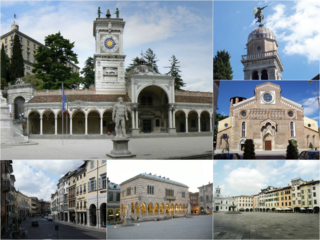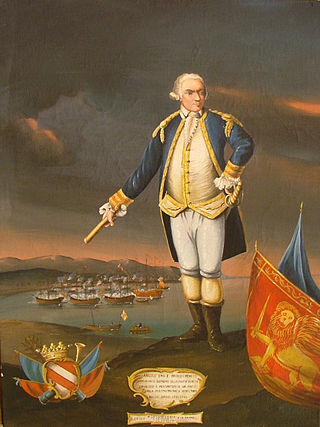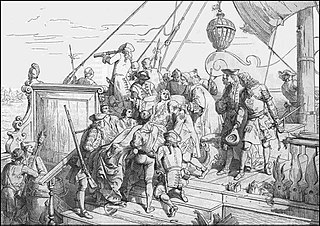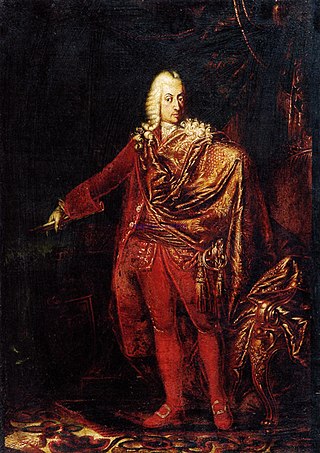
Udine is a city and comune in north-eastern Italy, in the middle of the Friuli Venezia Giulia region, between the Adriatic Sea and the Alps. Its population was 100,514 in 2012, 176,000 with the urban area.

The Republic of Venice or Venetian Republic, traditionally known as La Serenissima, was a sovereign state and maritime republic in parts of present-day Italy that existed for 1100 years from AD 697 until AD 1797. Centered on the lagoon communities of the prosperous city of Venice, it incorporated numerous overseas possessions in modern Croatia, Slovenia, Montenegro, Greece, Albania and Cyprus. The republic grew into a trading power during the Middle Ages and strengthened this position during the Renaissance. Citizens spoke the still-surviving Venetian language, although publishing in (Florentine) Italian became the norm during the Renaissance.

The bucentaur was the ceremonial barge of the doges of Venice. It was used every year on Ascension Day up to 1798 to take the doge out to the Adriatic Sea to perform the "Marriage of the Sea" – a ceremony that symbolically wedded Venice to the sea.
The Battle of Mytilene was a naval battle that occurred on 8 September 1690 at Mytilene between a Venetian fleet under Daniele Dolfin and a combined Muslim fleet made up of Ottoman and Barbary ships. The battle resulted in a victory for the Venetian naval forces. This defeat inspired Suleiman II to end Ottoman reliance on Barbary pirates.

The Battle of Matapan took place on 19 July 1717 off the Cape Matapan, on the coast of the Mani Peninsula, now in southern Greece. The naval battle was between the Armada Grossa of the Republic of Venice, supported by a mixed squadron of allied ships from Portugal, the Papal States and Malta, and the Ottoman fleet, under Kapudan Pasha Eğribozlu İbrahim Pasha.

Angelo Emo was a Venetian noble and admiral, mostly known for being the last admiral of the Republic of Venice to lead the Venetian navy to battle. Distinguished for his seamanship since early in his career, he introduced reforms based on the practices of the British Royal Navy, and led raids on the harbours of the Beylik of Tunis in retaliation for corsair attacks on Venetian-flagged shipping.

The Lagunari Regiment "Serenissima" is the an active unit of Italian Army's infantry arm's amphibious Lagunari speciality. The name of the specialty comes from the Italian word for lagoon, while the regiment's name "Serenissima" commemorates the Most Serene Republic of Venice. The regiment is based in Venice and assigned to the Cavalry Brigade "Pozzuolo del Friuli". The "Pozzuolo del Friuli" brigade forms, together with the Italian Navy's Third Naval Division and San Marco Marine Brigade, the Italian Armed Forces' Sea Projection Force.

The Domini di Terraferma was the hinterland territories of the Republic of Venice beyond the Adriatic coast in Northeast Italy. They were one of the three subdivisions of the Republic's possessions, the other two being the original Dogado (Duchy) and the Stato da Màr.

The Venetian Most Serene Government, whose members are often referred to as Serenissimi, is a political organization active in Veneto. The group's goal is independence and self-government for Venetian lands and it is a bulwark of Venetian nationalism.

Venezia Football Club, commonly referred to as Venezia, is a professional football club based in Venice, Italy, that currently plays in Serie B.

The Venetian navy was the navy of the Venetian Republic which played an important role in the history of the republic and the Mediterranean world. It was the premier navy in the Mediterranean Sea for many centuries between the medieval and early modern periods, providing Venice with control and influence over trade and politics far in excess of the republic's size and population. It was one of the first navies to mount gunpowder weapons aboard ships, and through an organised system of naval dockyards, armouries and chandlers was able to continually keep ships at sea and rapidly replace losses. The Venetian Arsenal was one of the greatest concentrations of industrial capacity prior to the Industrial Revolution and responsible for the bulk of the republic's naval power.

The Leon Trionfante-class were a class of at least fourteen 70-gun third rate ships of the line built by the Venetian Arsenale from 1716 to 1785, in four different series with minor changes in the ships' length. In 1797, when Venice fell to the French, Napoleon captured several ships of the class, still unfinished in the Arsenal: he chose one of them, forced the shipbuilders to have it completed and added it to his fleet en route for Egypt. After Campoformio, the remaining vessels were destroyed by the French to avoid their capture by the Austrian Empire.
The Corona was a one-member ship of the line class, a 76-gun third rate. It was built in 1712 by the Venetian Arsenal, and was one of the bigger and better armed vessels of the Venetian Navy. Its guns were all made in bronze for prestige reasons. The ship, even if it was a well-made one, was not copied, and the Navy chose to skip to the cheaper Leon Trionfante class instead.
The San Lorenzo Zustinian class were a class of at least twenty-nine 70-gun third rate ships of the line built by the Venetian Arsenale from 1691 to 1746, in three different series with minor changes in the ships' length. It was the most numerous class of ship of the line built in Venice, and the last to see active service in a war against the Ottoman Empire in 1718. All this class' ships were planned before 1720, and the vast majority was launched before the Peace of Passarowitz. The last four vessels were completed to 70% in 1720s, then stored in the roofed shipbuilding docks of the Arsenale to be finished and launched between 1739 and 1746, a solution that was widely used with the following Leon Trionfante-class.

The fall of the Republic of Venice was a series of events that culminated on 12 May 1797 in the dissolution and dismemberment of the Republic of Venice at the hands of Napoleon Bonaparte and Habsburg Austria.

The Magistrato alla Sanità was the office of the Republic of Venice definitively instituted in 1490 to manage public health in the city of Venice and its territories, with specific attention on preventing the spread of epidemics within the maritime republic. The magistracy was among the first health authorities in Europe to institute public inoculation projects to prevent the spread of infectious diseases.

Andrea Pisani was a Venetian noble who served as Captain General of the Sea during the Seventh Ottoman–Venetian War.

Lodovico Flangini was a Venetian noble who served as Capitano Straordinario delle Navi during the Seventh Ottoman–Venetian War.

Carlo Aurelio Widmann was a Venetian patrician, naval officer, and the last Provveditore Generale da Mar of the Venetian overseas empire, from 1794 to the Fall of the Republic of Venice in 1797.















